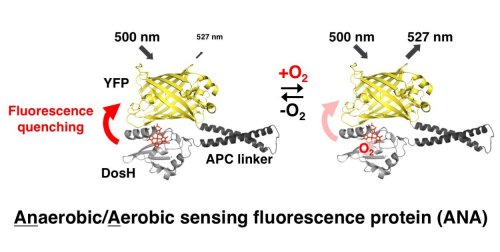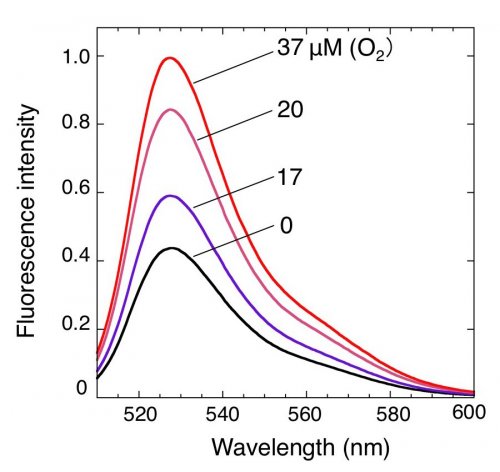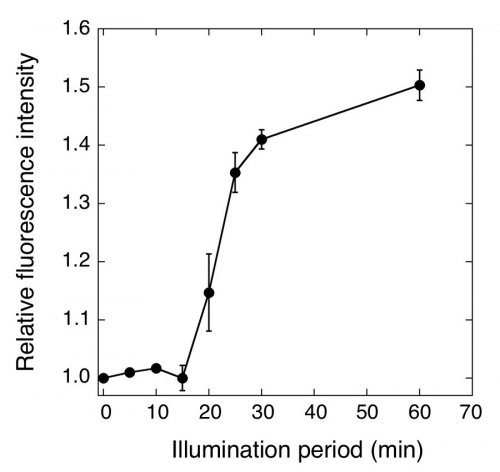Latest Research
- 2018.12.19
- Hisabori-Wakabayashi Group
- Hisabori-Wakabayashi Group
- Hisabori-Wakabayashi Group
- Hisabori-Wakabayashi Group
- Hisabori-Wakabayashi Group
- Hisabori-Wakabayashi Group
- Hisabori-Wakabayashi Group
- Hisabori-Wakabayashi Group
- Hisabori-Wakabayashi Group
- Hisabori-Wakabayashi Group
Developing a novel oxygen sensing fluorescence protein probe
Oxygen (O2) is essential for aerobic life and is required for various oxygen-dependent biochemical reactions such as respiration. Rapid and accurate measurement of oxygen levels inside living cells could be useful in biological research. To this end, various methods have been developed for measuring the intracellular oxygen concentrations, however, intracellular oxygen dynamics are not well understood until now, largely due to the absence of suitable oxygen sensors that can be used in living cells.
We utilized a natural oxygen-sensing protein named the direct oxygen sensor protein (DosP) from the bacterium. DosP has the ability to either bind or release oxygen depending on the oxygen levels inside the cell, like as the oxygen transporting protein hemoglobin. Finally we developed a genetically encoded oxygen sensor protein using the oxygen sensor domain of DosP, which was conjugated to yellow fluorescence protein (YFP) using an optimized linker (Figure 1). We named our novel oxygen sensor probe as ANA sensor1,2 (anaerobic/aerobic sensing fluorescence protein).
Figure 1. Molecular design of the novel oxygen sensor protein probe, ANA sensor. ANA sensor is operated by the fluorescence quenching mechanism caused by heme, and emits stronger fluorescence in the presence of oxygen.
We found that ANA sensor is highly sensitive to oxygen and increased its fluorescence intensity in the presence of oxygen, thereby successfully tracking the dynamic changes in oxygen content (Figure 2).
Figure 2. Fluorescence intensity change of ANA sensor under the various oxygen concentration.
By using the ANA sensors, photosynthetic oxygen production from cyanbacteria, a photosynthetic bacterium, could be monitored (Figure 3).
Figure 3. Monitoring photosynthetic oxygen production by cyanobacteria using ANA sensors. Emission intensities of ANA solution suspending cyanobacteria cells were monitored.
ANA sensors are operated by fluorescence quenching mechanism, and exhibit reversible fluorescence change of donor fluorescent protein following reversible absorbance change of acceptor heme protein. Most of currently invented sensor protein probes are designed based on conformational changes following binding of substrate or changes in microenvironments. Importantly, the mechanism adopted for ANA sensors could be used to develop various protein sensor probes for intracellular signaling molecules using numerous natural proteins exhibiting negligible structural changes but significant absorption changes upon binding of substrate or effecter molecules. Thus, ANA will expand the possibilities for the development of novel protein sensor probes.
Recent research demonstrated that the role of oxygen as a signaling molecule and the regulation of various metabolic pathways by oxygen. Oxygen dynamics on multiple metabolisms will be hopefully visualized by using ANA sensors in the future.
1) Jiro Nomata, Toru Hisabori Patent application 2017-040778
2) Nomata J, Hisabori T. Sci Rep. 2018 Aug 7;8(1):11849, DOI:10.1038/s41598-018-30329-5






